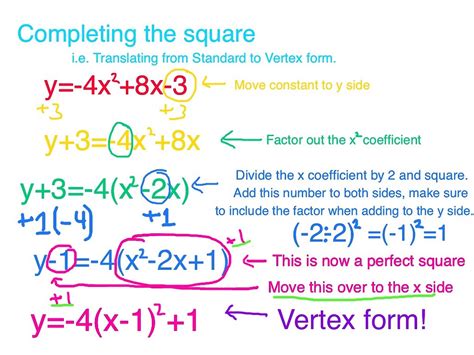The world of quadratic equations can be daunting, but with the right tools and techniques, mastering vertex form by completing the square can become a breeze. In this article, we'll delve into the 5 essential steps to help you conquer this fundamental concept in algebra.
Vertex form is a powerful way to express quadratic equations, offering a clear and concise representation of the parabola's shape, size, and position. By completing the square, you'll be able to transform any quadratic equation into vertex form, unlocking a wealth of possibilities for graphing, analyzing, and solving problems.
What is Vertex Form?

Vertex form is a way to express a quadratic equation in the form y = a(x-h)^2 + k, where (h,k) represents the coordinates of the parabola's vertex. This form provides valuable information about the parabola's shape, including its vertex, axis of symmetry, and the direction it opens.
Why is Vertex Form Important?
Vertex form is essential in various algebraic and real-world applications, such as:
- Graphing quadratic equations
- Analyzing functions
- Solving optimization problems
- Modeling real-world phenomena
Step 1: Write the Quadratic Equation in Standard Form

The first step to mastering vertex form is to express the quadratic equation in standard form, which is ax^2 + bx + c. This form provides the foundation for completing the square.
Example: Write the quadratic equation x^2 + 6x + 8 in standard form.
x^2 + 6x + 8
Note: The equation is already in standard form, with a = 1, b = 6, and c = 8.
Step 2: Move the Constant Term to the Right Side
Step 2: Move the Constant Term to the Right Side

The second step is to isolate the constant term on the right side of the equation. This step is crucial for completing the square.
Example: Move the constant term to the right side of the equation.
x^2 + 6x = -8
Note: The constant term, 8, has been moved to the right side of the equation.
Step 3: Complete the Square
Step 3: Complete the Square

The third step is to complete the square by adding and subtracting the square of half the coefficient of x. This step transforms the quadratic equation into a perfect square trinomial.
Example: Complete the square for the equation x^2 + 6x = -8.
x^2 + 6x + 9 = -8 + 9
(x + 3)^2 = 1
Note: The equation has been transformed into a perfect square trinomial, with the square of half the coefficient of x (3) added and subtracted.
Step 4: Write the Equation in Vertex Form
Step 4: Write the Equation in Vertex Form

The fourth step is to express the equation in vertex form, which is y = a(x-h)^2 + k.
Example: Write the equation (x + 3)^2 = 1 in vertex form.
y = (x + 3)^2 - 1
Note: The equation is now in vertex form, with (h,k) = (-3, -1).
Step 5: Interpret the Vertex Form
Step 5: Interpret the Vertex Form

The final step is to interpret the vertex form, which provides valuable information about the parabola's shape and position.
Example: Interpret the vertex form y = (x + 3)^2 - 1.
- The vertex is at (-3, -1).
- The axis of symmetry is x = -3.
- The parabola opens upward.
Note: The vertex form provides a clear and concise representation of the parabola's shape and position.
By following these 5 essential steps, you'll be able to master vertex form by completing the square. Remember to practice, practice, practice to become proficient in this fundamental concept in algebra.
What is the main purpose of completing the square?
+The main purpose of completing the square is to transform a quadratic equation into vertex form, which provides valuable information about the parabola's shape and position.
What is the vertex form of a quadratic equation?
+The vertex form of a quadratic equation is y = a(x-h)^2 + k, where (h,k) represents the coordinates of the parabola's vertex.
How do I complete the square?
+To complete the square, add and subtract the square of half the coefficient of x to the quadratic equation, then factor the perfect square trinomial.
